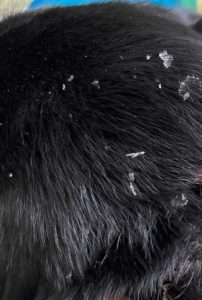Cheyletiellosis in dogs is a condition caused by a mite called cheyletiella. The mite lives on the surface of the skin. It can affect dogs of any age but is more common in puppies. Cheyletiellosis is fairly uncommon in dogs. It usually only causes mild symptoms, such as itching and flaky skin, and is normally simple to treat.
Cheyletiellosis is contagious; most dogs catch it from direct contact with infected dogs, cats, rabbits or other animals. It also can spread to humans, though luckily, this is not common. Cheyletiellosis is also known as “walking dandruff”, rabbit mites or Cheyletiellosic mange.
Overview
What is cheyletiellosis in dogs?
Cheyletiellosis in dogs is an infestation with a mite that lives on the surface of the skin.
- Cheyletiella mites are very small but can sometimes be seen with a magnifying glass or the naked eye.
- The mites look like small white flakes that move around, hence the name “walking dandruff”
- Cheyletiellosis is spread through direct contact with an infected animal, often in areas where there are large populations of dogs, such as kennels, breeders or shelters. It can spread through indirect contact too, on objects like blankets. It may also be able to spread through fleas and lice.
- It’s common in puppies that are bought from puppy farms or kept in less than ideal conditions.
- Some animals can carry and spread the mites but have no symptoms.
- The symptoms usually take around 3-4 weeks to clear with medication.
- An infestation with cheyletiella does not cause any long-term problems if it’s diagnosed and treated appropriately.
Do you have any questions about mites or skin problems in dogs? Download the app and call us now. Our vets are available 24 hours a day.
Symptoms
Symptoms of cheyletiellosis in dogs
The most common signs of cheyletiellosis include:
- Itchy skin leading to scratching or biting; usually mild
- Flaky skin or dandruff
- Hair loss: the area usually starts small and gets larger with time
Skin lesions are most commonly found along the back, between the neck and tail.

- Cheyletiella is also known as “walking dandruff”
Risk
Are some dogs more at risk of cheyletiellosis than others?
Cheyletiellosis is uncommon in healthy adult dogs.
Dogs at risk include:
- Puppies
- Elderly dogs
- Immunocompromised dogs
- Certain breeds: Boxers and Cavalier King Charles Spaniels
Diagnosis
How is cheyletiellosis in dogs diagnosed?
The diagnosis of cheyletiellosis in dogs is usually based on the physical exam (finding dandruff) and symptoms of itching. Your vet will usually take a sample of the skin or hair to confirm the mite under the microscope.
Other tests that may be included to rule out other conditions:
- Skin scrapes
- Hair pluck
- Skin biopsy
Is my family at risk of catching cheyletiellosis?
It is possible for cheyletiella to cause itching and rashes in humans. Spread from dogs to humans is uncommon but contact your GP if you have any concerns. It can also spread between pets in the house, including cats and rabbits.
Vet treatment
Vet treatment for cheyletiellosis in dogs
Your vet will prescribe anti-parasite control to kill the mites, usually a spot-on treatment. This may need to be repeated a few times to prevent a recurrence.
Other treatments may include:
- Oral antibiotics or antibacterial shampoo may be recommended for secondary skin infections
- Anti-itch medication, though this is not commonly required
Home treatment
How to look after a dog with cheyletiellosis at home
- All in-contact pets should be treated with vet-recommended anti-parasite control
- Routine cleaning of the house and car is advised. Hoover the whole house and disinfect any surfaces that your dog has been in close contact with. Wash all bedding and grooming equipment.
- Most household sprays that kill fleas are often effective against cheyletiella too
Prevention
Tips on how to prevent cheyletiellosis in dogs
Many dog flea preventatives will also prevent cheyletiellosis. Products containing fipronil, selamectin or imidacloprid/moxidectin are known to be effective.
Speak to a vet before you use parasite-control, some products may be harmful to dogs.
When to worry
When to worry about cheyletiellosis in dogs
Seek help from a vet if your dog:
- Is constantly scratching themselves
- Has skin problems but is also lethargic or vomiting
Call us and speak to one of our Joii Vets if:
- You have any questions about parasite control in dogs
- You need help using a spot-on treatment on your dog
- Your dog has been in contact with an animal infected with cheyletiellosis








